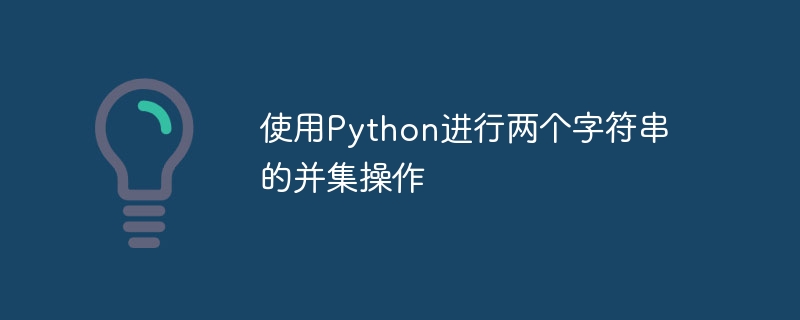
Python是全球程式設計師常用的語言之一,用於各種不同的目的,如機器學習、資料科學、Web開發以及執行許多其他自動化操作。它具有許多不同的功能,可以幫助我們在許多不同的專案上工作。 Python的一個特性就是聯合操作。聯合運算是指將兩個不同的字串合併為一個公用字串,同時刪除兩個字串中的所有公用元素。在本文中,我們將學習可以用於兩個字串的聯合操作的不同方法。
Sets是Python中提供的一種功能,用於將多個項儲存在一個資料集中。它具有一個內建功能,可以從字串中刪除所有共同的元素。讓我們舉一個例子來更好地理解它:
def multiple_strings(first, second): # The input of both the strings are given
data1 = set(first) # Both the strings are then converted into data sets
data2 = set(second)
union_data = data1.union(data2) # After conversion, the data sets are combined with the help of union operation
final_string = ''.join(union_data) # The Combined data set is then converted back into strings
return final_string
# Example
first = "What" # The two input strings are defined
second = "Where"
final_result = multiple_strings(first, second) # The function multiple_strings is run
print(final_result) # The output after union Operation Will be shown
上面範例的輸出將如下所示:
Wraeth
在這個方法中,我們將使用Python字典進行並集操作。字典將用於將所有資料儲存為字串,然後對其進行並集操作。透過這種方法進行並集操作的範例如下:
def multiple_strings(first, second): # The input of both the strings are given
union_dict = {} # A new dictionary is created for the union operation
for char in first: # All the elements in both the strings are checked and then they are added in the new dictionary created
union_dict[char] = True
for char in second:
union_dict[char] = True # No duplicate characters will be added because dictionary keys will take input of different characters only
union_string = ''.join(union_dict.keys()) # Once the union operation of the keys is performed, then we will convert the dictionary key back into string
return union_string
# Example
first = "What" # The two input strings are defined
second = "Where"
final_result = multiple_strings(first, second) # The function multiple_strings is run
print(final_result) # The output after union Operation Will be shown
The output of the above example will look as follows:
Whater
這是一個非常簡單的執行並集操作的方法。我們只需要將字串轉換為列表進行並集操作。這種方法的範例如下:
def multiple_strings(first, second): # The input of both the string is given
combined_strings = list(first) # The first string is converted into a list
for char in second: #If the element in second string is not present in first string then they are combined into the first list and the union operation is performed
if char not in combined_strings:
combined_strings.append(char)
final_string = ''.join(combined_strings) #The lists are then converted back into string
return final_string
# Example
first = "What" # The two input strings are defined
second = "Where"
final_result = multiple_strings(first, second) # The function multiple_strings is run
print(final_result) # The output after union Operation Will be shown
The output of the above example will look as follows:
Whater
這個方法是一種複雜的方法,不應該在簡單的組合情況下使用。在這個方法中,字串被轉換成集合,然後我們將使用管道運算子而不是直接使用並集。讓我們舉個例子來更好地理解:
def multiple_strings(first, second): # The input of both the string is given
first_set = set(first) # Both the strings are converted into sets
second_set = set(second)
final_string = ''.join(first_set | second_set) # Using the pipe operator the respective sets are combined after removing the common elements
return final_string
# Example
first = "What" # The two input strings are defined
second = "Where"
final_result = multiple_strings(first, second) # The function multiple_strings is run
print(final_result) # The output after union Operation Will be shown
上面範例的輸出將如下所示:
Wraeth
itertools模組用於有效率地檢查資料集中的所有循環。它有許多不同的函數,可以用於許多不同的目的。我們將使用兩個不同的函數來執行並集操作。讓我們透過一個例子來更好地理解:
import itertools # Do not forget to import itertools or else error might occur
def unique_everseen(iterable, key=None):
seen = set()
seen_add = seen.add
if key is None: # The input of both the string is given
for element in itertools.filterfalse(seen.__contains__, iterable):# Through the chain() function we will combine both the strings into cone common string
seen_add(element)
yield element
else:
for element in iterable:
k = key(element)
if k not in seen:
seen_add(k)
yield element
def multiple_strings(first, second): # The input of both the string is given
union_string = ''.join(unique_everseen(itertools.chain(string1, string2)))# With the help of unique.everseen() function we will remove all the common elements from the combined string
return union_string
# Example
first = "What" # The two input strings are defined
second = "Where"
final_result = multiple_strings(first, second) # The function multiple_strings is run
print(final_result) # The output after union Operation Will be shown
The output of the above example will look as follows:
Wraeth
了解可以用於執行並集操作的不同方法非常重要。本文介紹了可以用於執行並集操作的不同方法。根據方便和應用領域,可以使用上述任何方法之一。
以上是使用Python進行兩個字串的並集操作的詳細內容。更多資訊請關注PHP中文網其他相關文章!




